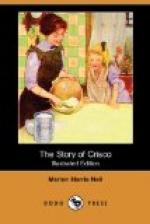Stewing
Stewing is cooking slowly with a small quantity of liquid in a covered vessel. The method is specially suitable for the coarser and cheaper parts of meat, which are rendered tender without loss of their juices. The usual plan is to make a gravy flavored and colored to suit the stew, and after the ingredients are well blended and cooked to lay the meat in the boiling liquid. After about two minutes boiling, the temperature is reduced to simmering, about 160 deg. F., a lower temperature than that required for a large joint of “boiled” meat. The time depends greatly on the quality of the meat, but none will stew satisfactorily in less than from one and a half to two hours, and the longer allowance is to be preferred.
Broiling
Broiling, sometimes called grilling, is cooking by the direct action of fire brought almost into contact with the meat. The outer surface is burned or seared, the albumen hardened and the juices, which have a tendency to escape on the side turned from the heat, are retained in the meat by frequent turning. The fire for broiling must be very clear, intensely hot and high in the grate. The utensil required for broiling is a gridiron, the bars of which are greased and heated to prevent sticking and subsequent tearing of the meat. The gridiron is laid quite close over the heat, so that the lower surface is dried and hardened at once.
The meat must be turned at very short intervals before the juices have been driven from the heat to the opposite surface. If once allowed to reach the surface, they will be thrown off in turning and lost, the meat being correspondingly impoverished. By constant turning the juices are kept moving backwards and forwards, and the meat remains moist and full of flavor. Each side should be exposed to the fire about three times, and it is not desirable to use meat less than one inch or more than one and a half to two inches thick for the purpose.
The thinner pieces should have even greater heat applied than the thick ones, as the longer thin ones are exposed to the fire the more dry and tasteless they become, while the thicker pieces may be slightly withdrawn after thoroughly hardening the surface and cooked rather more slowly that the heat may penetrate to the center. The frequent turning must be continued, or the juices will reach the hardened outer fibres, soften them, and escape.
If a double broiler is used the turning is managed easily, but with a single gridiron care must be taken not to puncture the meat by using a fork. Steak tongs are made for the purpose of lifting and turning broiled meat, but a spoon or a spoon and knife will answer. A single rim of fat on the chop or steak will tend to keep the edge moist and baste the meat, but too much will cause flame to rise in continuous jet, making the surface smoky. If there is absolutely no fat on the piece to be broiled, morsels of finely chopped suet may be occasionally thrown into the fire, so the sudden spurt of flame from this source leaves a deposit of fat on the meat which improves the flavor, and, without softening the albumen, prevents its becoming uneatably hard and dry.




